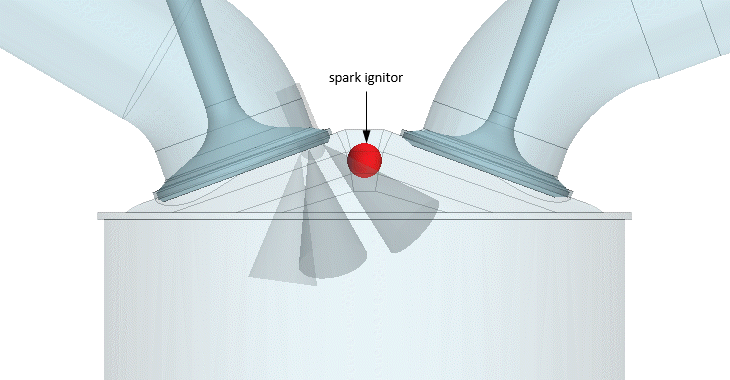Combustion and Ignition
Simcenter STAR-CCM+ In-cylinder offers efficient methods for simulating the combustion process in an internal combustion engine.
For a complete prediction of engine performance, an in-cylinder CFD simulation should give comprehensive insight into the wide-ranging physics of the device, such as turbulent mixing between fuel and air, ignition and combustion chemistry, the influence of exhaust gas recirculation (EGR) on the emissions, and the power output and efficiency.
Combustion
To simulate the above processes, Simcenter STAR-CCM+ In-cylinder provides the following combustion models:
- Extended Coherent Flame Model Three Zone (ECFM-3Z)
The ECFM-3Z model is a general-purpose combustion model that is capable of simulating the complex mechanisms of turbulent mixing, flame propagation, diffusion combustion, and pollutant emission that characterize modern internal combustion engines.
- Extended Coherent Flame Model with Combustion Limited by
Equilibrium Enthalpy (ECFM-CLEH)
The ECFM-CLEH model is a combustion model in which burning rates are limited by a thermodynamic equilibrium given by complex chemistry. This model provides a passive CO Emission model (optional), which accounts for the production of CO due to incomplete combustion.
- Specified Burn Rate
The Specified Burn Rate model allows you to pre-specify the fuel burning rate through an analytic function—the Wiebe function. As a result, you can avoid the calculation of chemical reaction rates based on complicated physical and chemical processes.
- Complex Chemistry
The Complex Chemistry model allows you to introduce detailed chemistry information to your ICE simulation. This combustion model can solve thousands of reactions among hundreds of species. The Complex Chemistry model requires detailed reaction mechanism information about species, reactions, thermodynamics, and transport properties. You supply these details using complex chemistry definition files in the Chemkin format.
To consider the turbulence effects on combustion, Simcenter STAR-CCM+ In-cylinder provides a Laminar Flame Concept (LFC) model and a Turbulent Flame Speed Closure (TFC) model.
A NOx prediction model is available in conjunction with both ECFM combustion models. The Nitrogen Oxide Relaxation Approach (NORA) is based on the tabulation of equilibrium values of three NOx species and their relaxation times following a perturbation. NORA makes a destiction between NO, NO2, and N2O. These products are represented separately in the model.
For the ECFM and the Complex Chemistry combustion models, Simcenter STAR-CCM+ In-cylinder supports the prediction of soot emissions. The formation and emission of carbonaceous particles is often observed during the combustion of hydrocarbons. These particulates, called soot, are identified in flames and fires as yellow luminescence. In gas turbines, internal combustion engines and other practical combustion devices, the formation of soot is mostly a product of incomplete combustion. The soot emission model in Simcenter STAR-CCM+ In-cylinder is based on a description of sections containing soot particles of equal volume, allowing a volume-based discretization of particle sizes together with conservation of the soot number density and mass.
For defining the exhaust gas composition and for setting the initial gas composition in the cylinder and ports, Simcenter STAR-CCM+ In-cylinder provides an automated approach—the Automatic Composition Initialization. The same automated approach is used for setting the gas composition at the flow boundaries. Automatic Composition Initialization calculates the composition of the gases as a function of the equivalence ratio at which combustion takes place and of the exhaust gas recirculation (EGR) percentage.
Spark Ignition
For starting the combustion process and for modeling the early stage of the flame kernel in a spark ignition internal combustion engine, Simcenter STAR-CCM+ In-cylinder provides the following spark ignition models:
- FI Spark Ignition
This ignition model comprises two stages: a first stage that models the time delay between the spark and the appearance of the flame surface and a second stage that takes care of the actual deployment of the flame surface in the mean gases.
- ISSIM Spark Ignition
This ignition model is a Eulerian spark-ignition model. The spherical kernel equation is used directly in the Eulerian transport equations, which allows a description of all local phenomena.
Simcenter STAR-CCM+ In-cylinder provides an Ignitor Engine Part, which offers a template for defining the position and physics of the ignitor.

After a specified ignition timing, Simcenter STAR-CCM+ In-cylinder fires the spark periodically every cycle.
Auto Ignition
Simcenter STAR-CCM+ In-cylinder allows you to account for a spontaneous ignition of the combustible mixture, without an external source of ignition. This phenomenon is called knock when it occurs in gasoline engines.
Simcenter STAR-CCM+ In-cylinder uses Tabulated Kinetic Ignition (TKI) tables to compute the ignition delay and establish the time when ignition occurs. The auto-ignition saturation coupling option takes into account the local equivalence ratio profile near fuel droplets and uses this as input for the TKI libraries. With this approach,ignition delay and auto-ignition reaction rates are derived from pre-computed tables based on complex chemistry. The TKI libraries are fuel dependant.